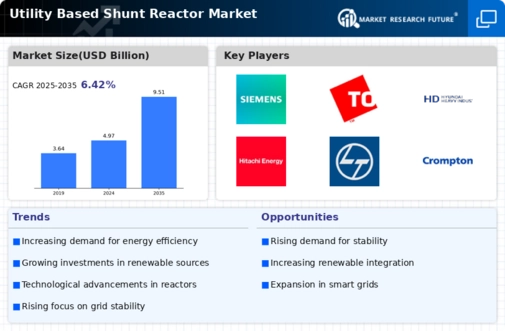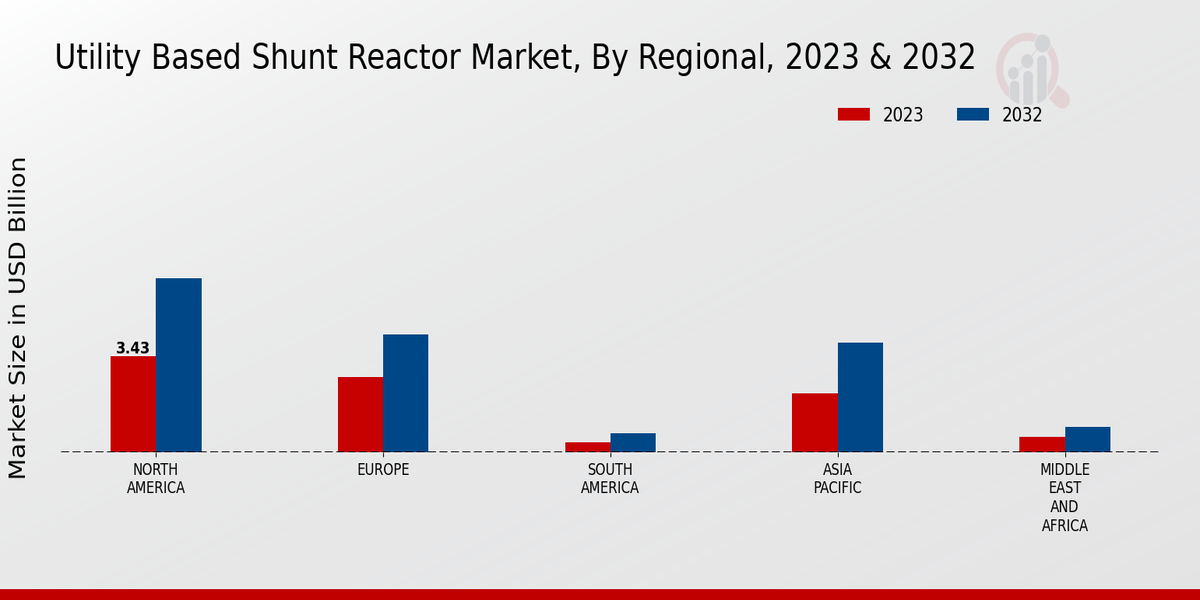Market Growth Projections
The Global Utility Based Shunt Reactor Market Industry is poised for substantial growth, with projections indicating a market value of 4.97 USD Billion in 2024 and an anticipated increase to 9.51 USD Billion by 2035. This growth trajectory suggests a compound annual growth rate of 6.08% from 2025 to 2035, reflecting the rising importance of shunt reactors in modern electrical grids. The increasing integration of renewable energy sources and the need for enhanced grid reliability are likely to drive this expansion. As utilities invest in advanced technologies, the demand for shunt reactors is expected to escalate, positioning the market for a robust future.
Regulatory Support for Grid Modernization
Regulatory frameworks promoting grid modernization are pivotal in shaping the Global Utility Based Shunt Reactor Market Industry. Governments are increasingly recognizing the importance of modernizing electrical infrastructure to accommodate growing energy demands and enhance reliability. Policies encouraging the deployment of advanced technologies, including shunt reactors, are likely to stimulate market growth. As utilities comply with these regulations, the demand for shunt reactors is expected to rise, contributing to a compound annual growth rate of 6.08% from 2025 to 2035. This regulatory support underscores the strategic importance of shunt reactors in achieving a resilient and efficient power grid.
Increasing Urbanization and Electrification
The Global Utility Based Shunt Reactor Market Industry is also influenced by increasing urbanization and electrification trends. As urban areas expand, the demand for reliable electricity supply intensifies, necessitating robust grid solutions. Shunt reactors are instrumental in managing the reactive power needs of densely populated regions, ensuring voltage stability and minimizing outages. This growing urban demand is expected to propel the market forward, aligning with the projected growth trajectory. The integration of shunt reactors into urban electrical systems is crucial for meeting the challenges posed by rapid urbanization and ensuring sustainable energy delivery.
Investment in Renewable Energy Infrastructure
The Global Utility Based Shunt Reactor Market Industry is significantly influenced by the ongoing investment in renewable energy infrastructure. As countries worldwide transition towards sustainable energy sources, the integration of wind and solar power into existing grids necessitates enhanced reactive power management. Shunt reactors are essential for mitigating voltage fluctuations caused by intermittent renewable generation. The market is expected to grow, with a forecasted value of 9.51 USD Billion by 2035, reflecting the increasing reliance on shunt reactors to support renewable energy integration. This investment not only promotes grid stability but also aligns with global sustainability goals.
Growing Demand for Reactive Power Compensation
The Global Utility Based Shunt Reactor Market Industry experiences a growing demand for reactive power compensation as electrical grids become increasingly complex. Shunt reactors play a crucial role in maintaining voltage stability and improving power quality. As utilities strive to enhance grid reliability, the adoption of shunt reactors is likely to rise. This trend is reflected in the projected market value of 4.97 USD Billion in 2024, indicating a robust investment in reactive power solutions. Moreover, as renewable energy sources are integrated into the grid, the need for effective reactive power management becomes even more pronounced, further driving the market's expansion.
Technological Advancements in Shunt Reactor Design
Technological advancements in shunt reactor design are driving innovation within the Global Utility Based Shunt Reactor Market Industry. Enhanced designs improve efficiency, reduce losses, and optimize performance, making shunt reactors more attractive to utilities. Innovations such as variable shunt reactors and smart grid integration capabilities are emerging trends that could reshape the market landscape. As utilities seek to modernize their infrastructure, these advancements are likely to facilitate the adoption of shunt reactors. The ongoing evolution in technology not only enhances operational efficiency but also supports the broader objectives of energy transition and grid reliability.


 Source: Primary Research, Secondary Research, Market Research Future Database and Analyst Review
Source: Primary Research, Secondary Research, Market Research Future Database and Analyst Review 









